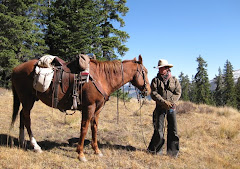
 I don’t know how many folks reading this have to deal with morning temperatures which regularly read anywhere from an even zero down to “off” – that’s what happens on my digital thermometer when the temperature sinks lower than 22 degrees below zero. And it does here.
I don’t know how many folks reading this have to deal with morning temperatures which regularly read anywhere from an even zero down to “off” – that’s what happens on my digital thermometer when the temperature sinks lower than 22 degrees below zero. And it does here.The challenge of providing the horses with winter water has always been an issue for us. We do not have open waters or a creek we can keep flowing or break into the surface ice each morning. The Rio Grande crosses our ranch, but the only way horses drop down the bluff to the river is when we ride them, and for better or for worse, we are not out there riding in the several feet of packed snow that winter brings. And anyway, the river gets about a foot or so of solid ice on its surface. Trying to fight the ice to keep the water flowing would be a loosing battle. In addition, our ranch is completely off-grid, and our solar electricity was not designed to keep a stock water heater going all night long every night for half the year. As a result, we’ve been dealing with smaller water buckets filled several times a day, and the habit of dumping out solid buckets of ice hours later.
Looks like we finally came up with a great solution. It does not take a constant flow of water, nor any power for heat or water movement, so it is extremely economical. We simply fill the large water trough every other day, close the lid at night, and open it during the day. Voila! Horse water without the ice!
The trick is that we insulated the water trough really well, and even built an insulated lid that is kept shut at night. So far we’ve made it to zero (yes, that’s Fahrenheit, so about -18 Celsius) without so much as a film of ice on the surface of the water in the morning when I open the lid.
Cost to us? $0. We started with an old black plastic stock tank we had been using for years but which would freeze solid each night in the past. Then we dug a hole about 18 inches deep and wider and longer than the tank. (A backhoe helps for this part of the job.) We set down several layers of sheet foam insulation that we had lying around below the tank, set in the tank just below the ground level keeping in mind that the horses can only lower their heads to drink to about the level of the front hooves. Then we built a box around the tank with an old panel of foam core insulation from a neighbors building project scrap pile. Around this, we nailed an external layer of 1”x4” scrap lumber, then back filled the dirt, piling extra around the back and sides, leaving the front as an easy ramp to the water for the horses. Next, we built a lid out of plywood, and glued on several layers of that sheet foam insulation. Neat thing here is that is silvery on the surface, so it reflects the sunlight back onto the water if we angle it just right, thereby helping to heat the water during sunlight hours. My son came up with a good simple rope and pulley system so that I can open and close the lid with one hand, and tie the lid up by hooking a loop around a nail so that it hangs closed just enough to direct the sunlight down onto the water, but not enough to be in the horses’ way.
Like so many things on this ranch, with our learning to adjust to the altitude and harsh climate, this is an experiment, but so far, so good. It’s working! We’ll see what happens when that thermometer drops to “off.”





